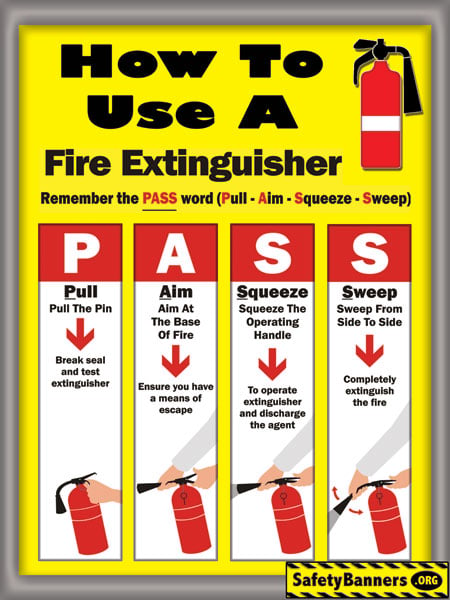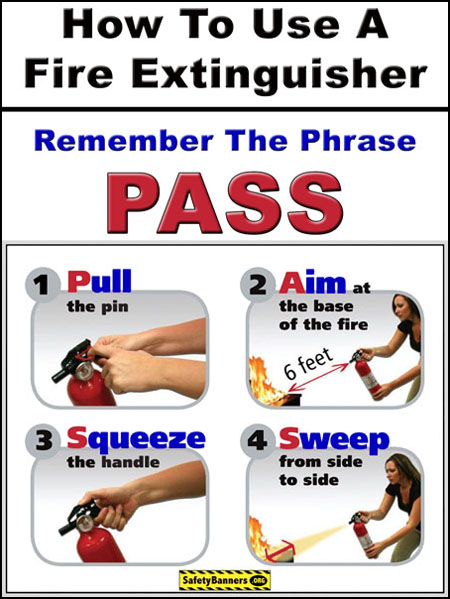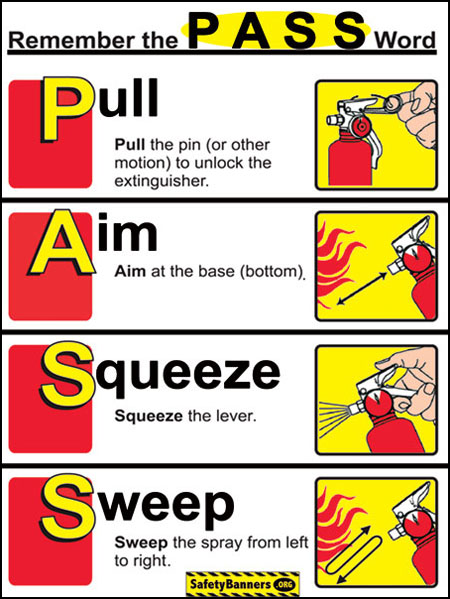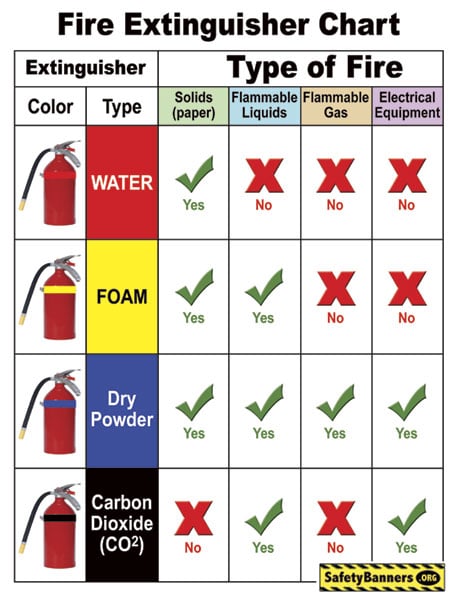FREE PASS Fire Extinguisher Use and Fire Safety Poster Download.
FREE - PASS Fire Extinguisher Use and Fire Extinguisher Types chart Safety Poster download. Our fire extinguisher use awareness safety banners & posters help in a fire emergency.
.
These PASS Fire Extinguisher use posters might also be appropriate to give to your employees for home safety.
CLICK HERE to see our most popular banners
CLICK HERE to see all our unique banners
CLICK HERE for our new safety store, Safety Banners USA (safetybannersUSA.com)
CLICK an image below to download it
PAPASS Fire Extinguisher Use is the most popular method of using a fire extinguisher. Our free PASS fire extinguisher use poster download fits perfectly on an 8 1/2" x 11" piece of paper.
CLICK HERE to see hundreds MORE safety products on our Safety Banners USA Store
CLICK HERE to see our NEW Framed Posters on our Safety Banners USA store.
PASS Fire Extinguisher Use is the most popular method of using a fire extinguisher. Our free PASS fire extinguisher use poster download fits perfectly on an 8 1/2" x 11" piece of paper. Down load it now for free and place one wherever you have a fire extinguisher. Fire safety and fire extinguisher use is an important part of every facility and home safety program.
The Use and Best Practices of Fire Extinguishers
Fire extinguishers are one of the most essential tools in any fire safety plan. They provide an immediate response to small fires and can prevent the escalation of dangerous situations, protecting lives and property. However, their effectiveness depends not only on having them available but also on their correct use and maintenance. This article will delve into the importance of fire extinguishers, how to use them properly, and best practices to ensure their readiness in emergencies.
• The Types of Fire Extinguishers
Before addressing the proper use and maintenance of fire extinguishers, it’s important to understand the different types available. Each extinguisher is designed for specific types of fires, categorized into different "classes" based on the materials involved.
- Class A Fire Extinguishers: These are for ordinary combustibles like wood, paper, cloth, and plastics. Water-based extinguishers are commonly used for Class A fires.
- Class B Fire Extinguishers: These are suitable for flammable liquids like gasoline, oil, grease, and other solvents. Dry chemical extinguishers and carbon dioxide (CO2) are commonly used.
- Class C Fire Extinguishers: Designed for electrical fires, which involve energized electrical equipment like wiring, circuit breakers, and appliances. Dry chemical and CO2 extinguishers are safe for this class as they don't conduct electricity.
- Class D Fire Extinguishers: These are for combustible metals like magnesium, aluminum, and titanium, which require specialized extinguishing agents.
- Class K Fire Extinguishers: Used in kitchens, these extinguishers are designed for fires involving cooking oils and fats. Wet chemical extinguishers are typically used for Class K fires.
• Importance of Choosing the Right Extinguisher
Using the correct fire extinguisher is critical. For example, using a water-based extinguisher on an electrical or grease fire can worsen the situation, spreading the flames or causing electrical shock. When selecting extinguishers for homes, businesses, or industrial settings, it's important to assess the type of potential fire risks in each area and ensure the appropriate extinguisher is on hand.
•How to Use a Fire Extinguisher: The PASS Method
PASS = Pull the Pin; Aim the nozzle; Squeeze the handle; Sweep from side to side
Using a fire extinguisher properly is a skill that everyone should know, especially in environments with potential fire risks. The acronym PASS is widely used to teach individuals how to operate a fire extinguisher effectively:
- Pull the pin: The first step is to pull the safety pin located at the top of the extinguisher. This pin prevents accidental discharge and must be removed to operate the device.
- Aim the nozzle: Point the nozzle or hose at the base of the fire, where the fuel is burning. This is crucial because aiming at the flames will not extinguish the fire — the goal is to eliminate the source of the combustion.
- Squeeze the handle: Firmly squeeze the handle to release the extinguishing agent. Be aware that this step will deplete the extinguisher’s contents, so avoid wasting it by only squeezing when ready to aim properly.
- Sweep from side to side: Move the nozzle from side to side while continuing to aim at the base of the fire. This sweeping motion ensures that the extinguishing agent covers the fire effectively.
Understanding the PASS method and practicing it regularly can make the difference between successfully extinguishing a fire and allowing it to spread.
• When Not to Use a Fire Extinguisher
While fire extinguishers are vital tools, it’s equally important to know when not to use them. Here are some key scenarios when attempting to fight a fire with an extinguisher may be dangerous:
- The fire is too large or spreading rapidly: Fire extinguishers are designed for small, contained fires. If the flames have already spread across a significant portion of the room, evacuate immediately and call the fire department.
- The room is filled with smoke: If visibility is poor and the room is filling with smoke, trying to extinguish the fire yourself can be fatal. Smoke inhalation is one of the leading causes of fire-related deaths.
- You don’t have the right type of extinguisher: If you are unsure of the type of fire and the extinguisher available, it is safer to evacuate and wait for emergency services. Using the wrong extinguisher can make the fire worse.
- You are unsure how to use the extinguisher: Lack of confidence or knowledge in handling an extinguisher can be dangerous. If you are untrained or uncertain, leave the building and contact the fire department.
• Best Practices for Fire Extinguisher Maintenance
Fire extinguishers require regular inspection and maintenance to ensure they are ready for use in an emergency. Follow these best practices to keep your extinguishers in working condition:
1. Regular Inspections
Monthly inspections should be carried out to verify that the extinguisher is operational. Look for the following during an inspection:
- Ensure the extinguisher is easily accessible and unobstructed.
- Check that the pressure gauge needle is in the green zone, indicating that it is properly pressurized.
- Inspect the extinguisher for any physical damage, corrosion, or leaks.
- Confirm that the pin and tamper seal are intact and have not been removed.
2. Annual Maintenance Check
At least once a year, a licensed professional should inspect fire extinguishers more thoroughly. They will:
- Conduct a more detailed physical inspection to check for damage or wear.
- Test the extinguisher’s pressure and recharge it if necessary.
- Ensure that the label and instructions are still legible and up-to-date.
3. Hydrostatic Testing
For most fire extinguishers, hydrostatic testing is required every 5 to 12 years, depending on the model. This test checks the cylinder for leaks or weaknesses that could cause it to fail during operation. A professional technician will perform this test and confirm whether the extinguisher can be returned to service or needs to be replaced.
4. Refill After Use
Even if a fire extinguisher has been partially discharged, it must be refilled or recharged after use. Extinguishers are not reusable until they are recharged by a qualified professional. A used extinguisher may not have sufficient pressure or extinguishing agent to work effectively during the next fire.
• Placement and Accessibility of Fire Extinguishers
Having fire extinguishers in the right locations is essential for quick and effective use. Follow these guidelines for proper placement:
- Install them in high-risk areas: Kitchens, garages, and workshops are common locations for fires to start. Ensure fire extinguishers are mounted in these areas.
- Keep them visible and unobstructed: Fire extinguishers should always be easily accessible and never hidden behind doors, furniture, or other obstacles. They should be clearly marked with signage so they can be located quickly during an emergency.
- Mount them at the right height: Fire extinguishers should be mounted on walls at a height that allows for easy access, typically about 3-5 feet from the ground.
- Install them near exits: Extinguishers should be located near exits so that, if a fire cannot be extinguished, people can quickly evacuate the building.
• Fire Extinguisher Training and Drills
In workplaces, schools, and public facilities, it is important that staff and occupants are trained in fire extinguisher use and participate in regular fire drills. Training ensures that individuals are familiar with the location of extinguishers, understand how to use them, and know when to evacuate instead of attempting to fight a fire. Fire drills also provide an opportunity to practice these skills in a controlled, safe environment.
Fire extinguishers are indispensable tools in fire safety, but their effectiveness depends on choosing the right type, using them correctly, and maintaining them regularly. By understanding how to use a fire extinguisher with the PASS method, performing routine inspections, and keeping them in easily accessible locations, you can help protect yourself and others from the dangers of fire. Remember, proper training and preparation are key to responding quickly and confidently in case of an emergency.
Thank You for the opportunity to be of service.
Memphis Tennessee
901-759-0932
SafetyBanners.Org, manufacturers of High Impact Safety Banners and safety products to Promote On The Job Safety. All images and designs are the property of New Tech Graphics and may not be reproduced without written permission. Manufactured on demand by New Tech Graphics - located in MEMPHIS, Tennessee, the Heart & Soul of Rock & Roll.
Have Questions? Email us, use the email us button top center, or call us at 901-759-0932 Central Time.
SafetyBanners.Org
1657 Shelby Oaks Drive North
Suite 101
Memphis, Tennessee 38134
901-759-0932






